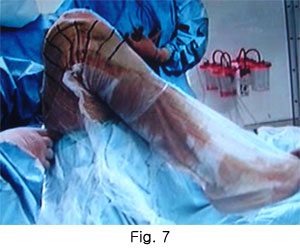
A way forward in the management of Severe Osteoarthrosis
- Dr. K. D. Tripathi
Total knee replacement is one of the most successful operations to exist in the field of Orthopaedic surgery. Over the last few decades it has become the mainstay in the treatment of the patient with advanced arthritis of the knee. Its results have become predictable and reproducible if done in properly indicated patients by well-experienced surgeons at appropriate operation theatres. Because of the latest technological advances in total knee replacement surgery and availability of improved implants, it is now possible to relieve pain and simultaneously provide full function to the affected limbs in an arthritic patient (fig 1). The purpose of this article is to analyse the benefits and drawbacks of conventional total knee arthroplasty and recent knee prostheses in perspective of suburban and rural population of Indian subcontinent.
Incidence of Osteoarthritis and painful knee in India is far more than any country in the world. Total Knee Arthroplasty which is most successful treatment of advance osteoarthrosis world over, has not been widely accepted by the suburban population of Indian subcontinent. Since our social & cultural habits requires full knee function i.e., bending upto 150-160°, which was not achieved in conventional Total knee Arthroplasty. The recent modifications & revolutions in Total Knee Arthroplasty in the form of Hi-Flex Total Knee Arthroplasty & Unichondylar Total knee Arthroplasty can provide full function of one of the key joint of the body, which is a boon for our own population as well as Arabian world.
There are some myths in our society that: the artificial joint doesn’t work well and there is a tissue reaction due to foreign material. It collapse after weight bearing, it loosens in the due course of time and knee bending is a great problem.
, but, truth is that the look and function of artificial joint is as good as natural joint, it is totally inert and biocompatible with body, there is no subsidence or collapse if it is well done. There is no loosening if prosthesis is well cemented and with the newer prosthesis knee bending is found to be as good as natural knee.
The knee joint is one of the largest and complex joint of the body. It provides us support and mobility for movements of our daily living like walking, sitting, squatting, turning, running, driving etc. Healthy knees are taken for granted without giving any thought about stresses it undergoes for all of us. We are forced to restrict our activities only when it becomes painful, stiff or swollen. It is only then we realize how much freedom of movement means to all of us.
Although knee joint replacement is recommended in older age group, it can be considered in younger patients who are severely crippled due to rheumatoid arthritis or post traumatic osteoarthritis of knees. As such, age is no bar to this operation.
To understand total knee replacement, one should be familiar with the structure of the knee, a complex joint consisting of three bones: the femur (thigh bone), the tibia (shin bone), and the patella (kneecap). When you bend or straighten your knee, the end of the femur rolls against the end of the tibia, and the patella glides in front of the femur.
With a healthy knee, smooth, weight-bearing surfaces allow for painless movement. Muscles and ligaments provide side-to-side stability. A membrane lines the joint. Cartilage acts as a cushion between the femur and tibia and is lubricated by synovial fluid.
With an arthritic knee, the cartilage .cushion. wears out. The bones rub together and become rough. The resulting inflammation and pain cause reduced motion and difficulty in walking.
Clinical and biomechanical research has steadily refined knee replacement methods and materials. Prosthesis durability can vary from patient to patient because each patient’s body places slightly different stresses on the new knee. However, the average patient can expect to obtain greater mobility and freedom from pain, which will, in turn, improve ability to walk.
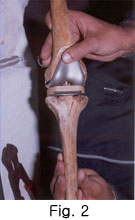 The femoral component is a cobalt chromium alloy, the patellar component is polyethylene, the tibial insert component is polyethylene as well, the tibial tray component (fig 2) can be made of either Cobalt chromium, Titanium or Polyethylene.
The femoral component is a cobalt chromium alloy, the patellar component is polyethylene, the tibial insert component is polyethylene as well, the tibial tray component (fig 2) can be made of either Cobalt chromium, Titanium or Polyethylene.
The weight-bearing surfaces of a total knee replacement are smooth, as in a normal knee. A femoral component covers the end of the thigh bone, a tibial component covers the top of the shin bone, and the patellar component covers the underside of the kneecap. The femoral component is made of a super alloy (chromium cobalt ) and is held in place by a cement methylmethacrylate). The patellar component is made of plastic (polyethylene) and is held in place with cement. The tibial component is made of either polyethylene or titanium covered by polyethylene.
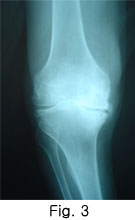 Every precaution should be taken before surgery for the patient of total knee arthroplasty. The patient undergoes a series of preoperative tests including preoperative x-rays (fig 3), blood samples for anaemia, sugar, infections, cardiac, liver function, renal function and neurological examinations. After full screening patient undergoes either spinal, epidural, general anaesthesia depending on the choice of anaesthesiologist. Surgery is performed in Hi-tech modern operation theatre having all the facility of anaesthesia and sterilization, including laminar airflow. After suitable anaesthesia the entire leg is then draped in sterile sheets and placed in a stocking set. It is kept elevated and a net coated with antiseptic placed on top. A tourniquet is fixed to prevent blood flow to the knee which is now ready for the operation.
Every precaution should be taken before surgery for the patient of total knee arthroplasty. The patient undergoes a series of preoperative tests including preoperative x-rays (fig 3), blood samples for anaemia, sugar, infections, cardiac, liver function, renal function and neurological examinations. After full screening patient undergoes either spinal, epidural, general anaesthesia depending on the choice of anaesthesiologist. Surgery is performed in Hi-tech modern operation theatre having all the facility of anaesthesia and sterilization, including laminar airflow. After suitable anaesthesia the entire leg is then draped in sterile sheets and placed in a stocking set. It is kept elevated and a net coated with antiseptic placed on top. A tourniquet is fixed to prevent blood flow to the knee which is now ready for the operation.
An incision is made through the stocking to open up the knee. Blood vessels are doubly checked to ensure there is no blood flow. Layers of fat and the surrounding soft tissue are pushed aside so that the bones – tibia and femur – within are revealed.
Using sharp instruments, the debris of the cartilage is removed. The roughened portions from the tibia and the femur are nibbled off. A thin section of the tibia bone surface is sliced off to accurately level the surface so that the artificial plate can easily sit on it.
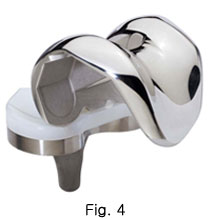 Cuts are made into the femur bone to allow the artificial knee frame to fit. A hole is drilled into the tibia so that the plate can be fixed to it. Another hole is made in the femur to reduce bone pressure. The idea is to minimise eventual strain on the artificial knee.
Cuts are made into the femur bone to allow the artificial knee frame to fit. A hole is drilled into the tibia so that the plate can be fixed to it. Another hole is made in the femur to reduce bone pressure. The idea is to minimise eventual strain on the artificial knee.
Bone cement – polymethymethyacrylate – is mixed into a thick liquid consistency. This is filled into the drilled holes and behind the two frames that make up the knee joint. The plate is finally placed on the tibia and femoral implant is fitted in the femur.
The implants are firmly pressed and hammered into position. The plastic plate, which pushes the joint, is attached over the tibia plate. A plastic implant is also fixed to the knee cap. Any remaining gaps are plugged with the cement, which hardens in about 10 minutes.
Once the artificial knee parts (fig. 4) are in place, a little tube is inserted to suck away any blood for the next two days to prevent infection. The main incision is then closed carefully using vicryl – a suturing material which dissolves after 90 days.
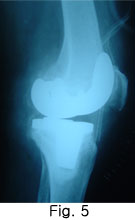 After the operation the physiotherapy starts the same evening and continues for six weeks. This is the crucial recovery period. Postoperative x-rays are taken after the surgery (fig. 5, fig. 6)
After the operation the physiotherapy starts the same evening and continues for six weeks. This is the crucial recovery period. Postoperative x-rays are taken after the surgery (fig. 5, fig. 6)
After four days patient is allowed a walker. After three weeks he’ll use a cane and after three months he’ll be normal.
There are some complications also to care with as infections in the form of micro-organisms could sneak in during the surgery process. Blood seepage, blood clot to affect circulation of blood. The major complication is when the artificial knee could not be fixed properly, resulting in pain.
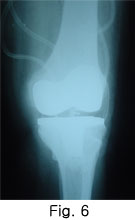 The result of this conventional total knee arthroplasty has been widely accepted world-over in the urban society as they need about 100 - 110° knee flexion, which is provided by this traditional knee prosthesis. While the people from suburban and rural population need more amount of flexion for their daily routine activities. The new advances like Hi-Flex total knee arthroplasty, the meniscal bearing TKR, the rotating platform TKR and unicondylar Knee arthroplasty provides knee function as good as the natural knee joint. This is because of the advanced surgical technique, improved quality of prosthesis and more modularity in knee prosthesis.
The result of this conventional total knee arthroplasty has been widely accepted world-over in the urban society as they need about 100 - 110° knee flexion, which is provided by this traditional knee prosthesis. While the people from suburban and rural population need more amount of flexion for their daily routine activities. The new advances like Hi-Flex total knee arthroplasty, the meniscal bearing TKR, the rotating platform TKR and unicondylar Knee arthroplasty provides knee function as good as the natural knee joint. This is because of the advanced surgical technique, improved quality of prosthesis and more modularity in knee prosthesis.
For Hi-Flex total knee arthroplasty patient should have flexion of knee upto 120° (fig. 7) before surgery and should also have need and desire to perform deep flexion after surgery and his thigh-calf index should be less than 90°. He should have stable and functional collateral ligament capsule and muscles around the knee and must not have any angular deformity of the knee joint. This procedure should not be encouraged in the obese and overweight patients.
Because of these increased and natural movements around the knee after joint replacement the acceptability of this procedure is increasing every day by the masses, but, high cost of prosthesis and procedure is still the limiting factor for the population segment which badly needs it, we wish that there is a hope in times to come this high quality prosthesis and surgery will become affordable for the masses and the surgery will not be limited to the high socio-economic class.




